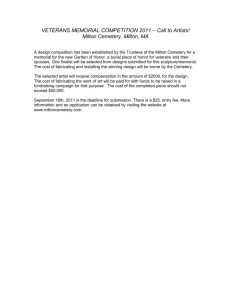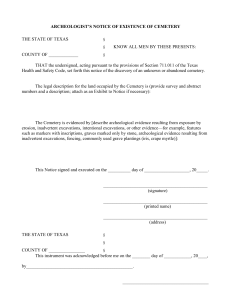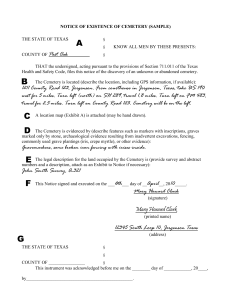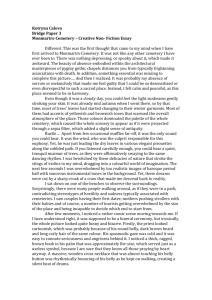A History of the Standish Burial Grounds Standish
advertisement
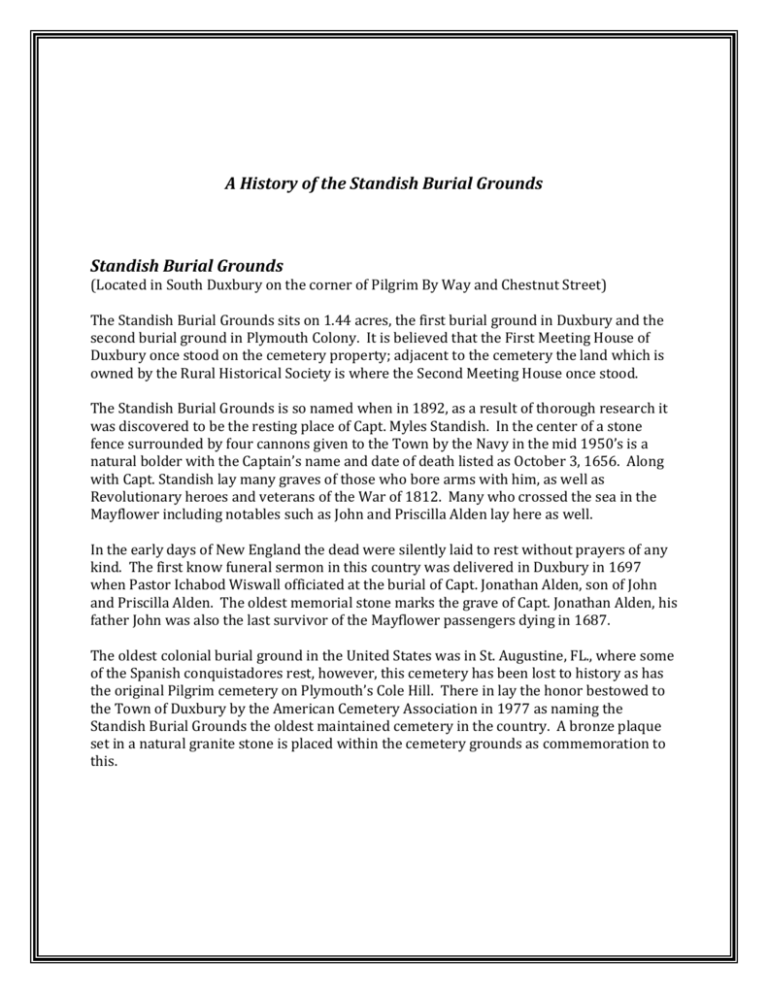
A History of the Standish Burial Grounds Standish Burial Grounds (Located in South Duxbury on the corner of Pilgrim By Way and Chestnut Street) The Standish Burial Grounds sits on 1.44 acres, the first burial ground in Duxbury and the second burial ground in Plymouth Colony. It is believed that the First Meeting House of Duxbury once stood on the cemetery property; adjacent to the cemetery the land which is owned by the Rural Historical Society is where the Second Meeting House once stood. The Standish Burial Grounds is so named when in 1892, as a result of thorough research it was discovered to be the resting place of Capt. Myles Standish. In the center of a stone fence surrounded by four cannons given to the Town by the Navy in the mid 1950’s is a natural bolder with the Captain’s name and date of death listed as October 3, 1656. Along with Capt. Standish lay many graves of those who bore arms with him, as well as Revolutionary heroes and veterans of the War of 1812. Many who crossed the sea in the Mayflower including notables such as John and Priscilla Alden lay here as well. In the early days of New England the dead were silently laid to rest without prayers of any kind. The first know funeral sermon in this country was delivered in Duxbury in 1697 when Pastor Ichabod Wiswall officiated at the burial of Capt. Jonathan Alden, son of John and Priscilla Alden. The oldest memorial stone marks the grave of Capt. Jonathan Alden, his father John was also the last survivor of the Mayflower passengers dying in 1687. The oldest colonial burial ground in the United States was in St. Augustine, FL., where some of the Spanish conquistadores rest, however, this cemetery has been lost to history as has the original Pilgrim cemetery on Plymouth’s Cole Hill. There in lay the honor bestowed to the Town of Duxbury by the American Cemetery Association in 1977 as naming the Standish Burial Grounds the oldest maintained cemetery in the country. A bronze plaque set in a natural granite stone is placed within the cemetery grounds as commemoration to this. A History of Mayflower Cemetery Mayflower Cemetery (Located on Tremont Street, Rte. 3A) The largest cemetery in Duxbury, Mayflower Cemetery so named for the ship that brought the Pilgrims to the New World, has over 40 acres of viable cemetery grounds and over 35 acres awaiting future development. With its massive oak trees Mayflower Cemetery is adjacent to the First Parish Church, Unitarian, the Church was built in 1840 and was used as the third and fourth Meeting House before being used as an official house of worship. The first grave was that of Stephen Russell in 1787, with his burial the Cemetery was established. In 1894 Town Meeting voted to assume the obligation for maintaining the 4 cemeteries which now include both the Smith and Weston Tombs and to establish standards of beauty and decency. In the same year the town elected its first Board of Cemetery Trustees which comprised of 5 citizens to be responsible for the care and maintenance of the cemeteries. The main entrance to the cemetery grounds has two Quincy granite posts on either side, these beautiful columns and the spheres that rest atop the posts were a gift from Mr. & Mrs. Ernest H. Bailey both descendants of the passengers on the Mayflower and were erected in 1927. This same year also saw a gift from Lucy Hathaway in memory of her mother, father and sister, Ms. Hathaway donated the fencing of granite and iron that begins to the left of the entrance and runs down 3A to Mayflower Street. Mayflower Cemetery is a viable cemetery opened year round from dusk to dawn, a showcase of historical monuments and a resting place to Revolutionary and Civil War Veterans, including descendents of those early settlers who traveled on the ship the Mayflower and to those who contributed such a vital part in establishing the Town of Duxbury. A History of the Smith and Weston Tombs SMITH TOMB (Located on the corner of Tremont and Depot Street, across from Boomer Square) WESTON TOMB (Located in West Duxbury on Lincoln Street) These tombs are prime examples of the tiny burial lots established by families during the 17th century. Families would locate and build these tombs, usually near a hillside on the far corner of land in which they owned for the purpose of burying the dead. The Smith and Weston Tombs have been very well preserved, partly because of family intervention and partly due to the proximity of these tombs both are easily accessible and are visible from the roadway. The Town of Duxbury like all New England towns had its share of private tombs and back yard graves, but most of the unregulated burial spots were so long neglected they are scarcely more than legend now. A HISTORY of ASHDOD and DINGLEY CEMETERY ASHDOD CEMETERY (Located in West Duxbury on Keene Street) DINGLEY CEMETERY (Located in North Duxbury on West Street) Dingley Cemetery is three quarter of an acre and Ashdod Cemetery is 1 acre. These two cemeteries, Dingley and Ashdod Cemetery were established principally to accommodate early settlers in the days when roads were little better than cow paths, posing a problem for horse drawn hearse and carriages to travel for burial to Mayflower Cemetery. Dingley Cemetery was once a family plot, but several other families are now interred there. To the far right in the cemetery grounds is an unassuming tomb, those who visit may not know it is there. Ashdod Cemetery is attached to what is now the “Free Christian Church,” whose building still stands adjacent to it on Keene Street.


